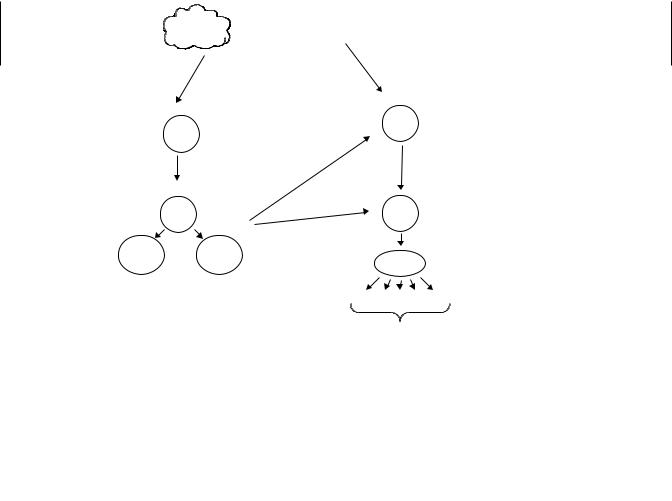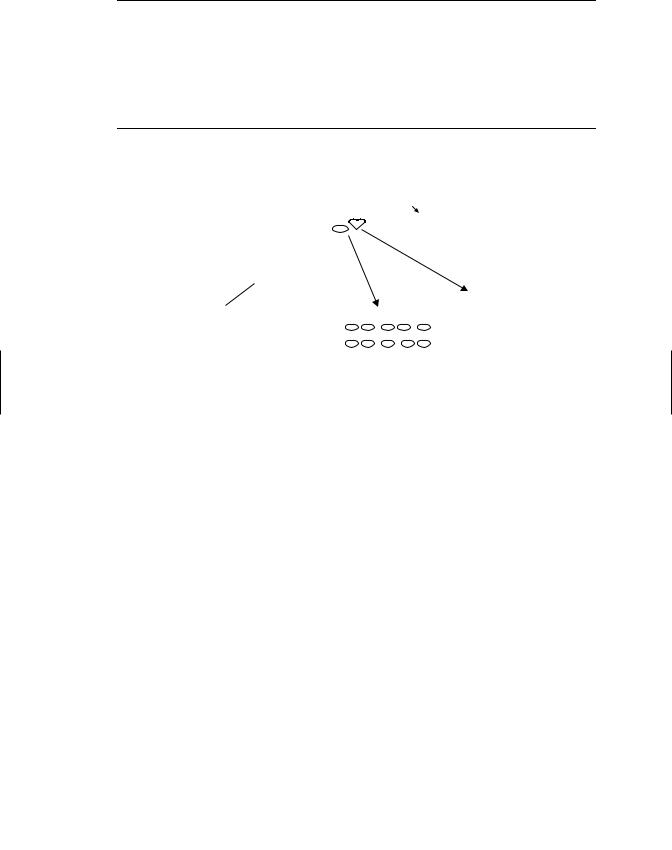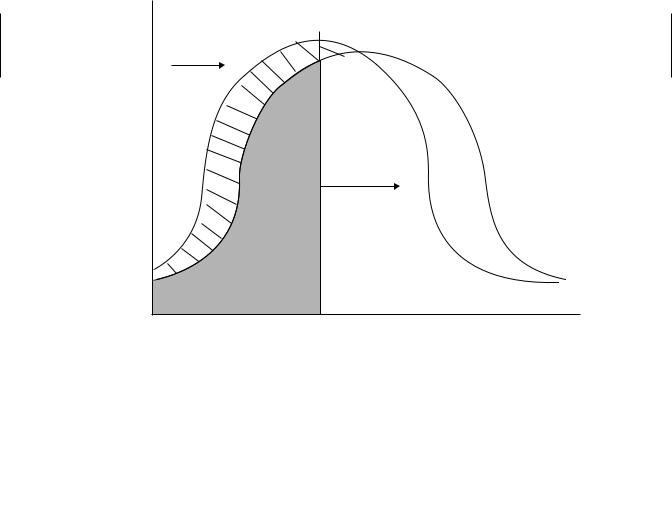
- •CONTENTS
- •Preface
- •Contributors
- •1 Introduction to Toxicology
- •1.1 Definition and Scope, Relationship to Other Sciences, and History
- •1.1.2 Relationship to Other Sciences
- •1.1.3 A Brief History of Toxicology
- •1.3 Sources of Toxic Compounds
- •1.3.1 Exposure Classes
- •1.3.2 Use Classes
- •1.4 Movement of Toxicants in the Environment
- •Suggested Reading
- •2.1 Introduction
- •2.2 Cell Culture Techniques
- •2.2.1 Suspension Cell Culture
- •2.2.2 Monolayer Cell Culture
- •2.2.3 Indicators of Toxicity in Cultured Cells
- •2.3 Molecular Techniques
- •2.3.1 Molecular Cloning
- •2.3.2 cDNA and Genomic Libraries
- •2.3.3 Northern and Southern Blot Analyses
- •2.3.4 Polymerase Chain Reaction (PCR)
- •2.3.5 Evaluation of Gene Expression, Regulation, and Function
- •2.4 Immunochemical Techniques
- •Suggested Reading
- •3.1 Introduction
- •3.2 General Policies Related to Analytical Laboratories
- •3.2.1 Standard Operating Procedures (SOPs)
- •3.2.2 QA/QC Manuals
- •3.2.3 Procedural Manuals
- •3.2.4 Analytical Methods Files
- •3.2.5 Laboratory Information Management System (LIMS)
- •3.3 Analytical Measurement System
- •3.3.1 Analytical Instrument Calibration
- •3.3.2 Quantitation Approaches and Techniques
- •3.4 Quality Assurance (QA) Procedures
- •3.5 Quality Control (QC) Procedures
- •3.6 Summary
- •Suggested Reading
- •4 Exposure Classes, Toxicants in Air, Water, Soil, Domestic and Occupational Settings
- •4.1 Air Pollutants
- •4.1.1 History
- •4.1.2 Types of Air Pollutants
- •4.1.3 Sources of Air Pollutants
- •4.1.4 Examples of Air Pollutants
- •4.1.5 Environmental Effects
- •4.2 Water and Soil Pollutants
- •4.2.1 Sources of Water and Soil Pollutants
- •4.2.2 Examples of Pollutants
- •4.3 Occupational Toxicants
- •4.3.1 Regulation of Exposure Levels
- •4.3.2 Routes of Exposure
- •4.3.3 Examples of Industrial Toxicants
- •Suggested Reading
- •5 Classes of Toxicants: Use Classes
- •5.1 Introduction
- •5.2 Metals
- •5.2.1 History
- •5.2.2 Common Toxic Mechanisms and Sites of Action
- •5.2.3 Lead
- •5.2.4 Mercury
- •5.2.5 Cadmium
- •5.2.6 Chromium
- •5.2.7 Arsenic
- •5.2.8 Treatment of Metal Poisoning
- •5.3 Agricultural Chemicals (Pesticides)
- •5.3.1 Introduction
- •5.3.3 Organochlorine Insecticides
- •5.3.4 Organophosphorus Insecticides
- •5.3.5 Carbamate Insecticides
- •5.3.6 Botanical Insecticides
- •5.3.7 Pyrethroid Insecticides
- •5.3.8 New Insecticide Classes
- •5.3.9 Herbicides
- •5.3.10 Fungicides
- •5.3.11 Rodenticides
- •5.3.12 Fumigants
- •5.3.13 Conclusions
- •5.4 Food Additives and Contaminants
- •5.5 Toxins
- •5.5.1 History
- •5.5.2 Microbial Toxins
- •5.5.3 Mycotoxins
- •5.5.4 Algal Toxins
- •5.5.5 Plant Toxins
- •5.5.6 Animal Toxins
- •5.6 Solvents
- •5.7 Therapeutic Drugs
- •5.8 Drugs of Abuse
- •5.9 Combustion Products
- •5.10 Cosmetics
- •Suggested Reading
- •6 Absorption and Distribution of Toxicants
- •6.1 Introduction
- •6.2 Cell Membranes
- •6.3 Mechanisms of Transport
- •6.3.1 Passive Diffusion
- •6.4 Physicochemical Properties Relevant to Diffusion
- •6.4.1 Ionization
- •6.5 Routes of Absorption
- •6.5.1 Extent of Absorption
- •6.5.2 Gastrointestinal Absorption
- •6.5.3 Dermal Absorption
- •6.5.4 Respiratory Penetration
- •6.6 Toxicant Distribution
- •6.6.1 Physicochemical Properties and Protein Binding
- •6.7 Toxicokinetics
- •Suggested Reading
- •7 Metabolism of Toxicants
- •7.1 Introduction
- •7.2 Phase I Reactions
- •7.2.4 Nonmicrosomal Oxidations
- •7.2.5 Cooxidation by Cyclooxygenases
- •7.2.6 Reduction Reactions
- •7.2.7 Hydrolysis
- •7.2.8 Epoxide Hydration
- •7.2.9 DDT Dehydrochlorinase
- •7.3 Phase II Reactions
- •7.3.1 Glucuronide Conjugation
- •7.3.2 Glucoside Conjugation
- •7.3.3 Sulfate Conjugation
- •7.3.4 Methyltransferases
- •7.3.7 Acylation
- •7.3.8 Phosphate Conjugation
- •Suggested Reading
- •8 Reactive Metabolites
- •8.1 Introduction
- •8.2 Activation Enzymes
- •8.3 Nature and Stability of Reactive Metabolites
- •8.4 Fate of Reactive Metabolites
- •8.4.1 Binding to Cellular Macromolecules
- •8.4.2 Lipid Peroxidation
- •8.4.3 Trapping and Removal: Role of Glutathione
- •8.5 Factors Affecting Toxicity of Reactive Metabolites
- •8.5.1 Levels of Activating Enzymes
- •8.5.2 Levels of Conjugating Enzymes
- •8.5.3 Levels of Cofactors or Conjugating Chemicals
- •8.6 Examples of Activating Reactions
- •8.6.1 Parathion
- •8.6.2 Vinyl Chloride
- •8.6.3 Methanol
- •8.6.5 Carbon Tetrachloride
- •8.6.8 Acetaminophen
- •8.6.9 Cycasin
- •8.7 Future Developments
- •Suggested Reading
- •9.1 Introduction
- •9.2 Nutritional Effects
- •9.2.1 Protein
- •9.2.2 Carbohydrates
- •9.2.3 Lipids
- •9.2.4 Micronutrients
- •9.2.5 Starvation and Dehydration
- •9.2.6 Nutritional Requirements in Xenobiotic Metabolism
- •9.3 Physiological Effects
- •9.3.1 Development
- •9.3.2 Gender Differences
- •9.3.3 Hormones
- •9.3.4 Pregnancy
- •9.3.5 Disease
- •9.3.6 Diurnal Rhythms
- •9.4 Comparative and Genetic Effects
- •9.4.1 Variations Among Taxonomic Groups
- •9.4.2 Selectivity
- •9.4.3 Genetic Differences
- •9.5 Chemical Effects
- •9.5.1 Inhibition
- •9.5.2 Induction
- •9.5.3 Biphasic Effects: Inhibition and Induction
- •9.6 Environmental Effects
- •9.7 General Summary and Conclusions
- •Suggested Reading
- •10 Elimination of Toxicants
- •10.1 Introduction
- •10.2 Transport
- •10.3 Renal Elimination
- •10.4 Hepatic Elimination
- •10.4.2 Active Transporters of the Bile Canaliculus
- •10.5 Respiratory Elimination
- •10.6 Conclusion
- •Suggested Reading
- •11 Acute Toxicity
- •11.1 Introduction
- •11.2 Acute Exposure and Effect
- •11.3 Dose-response Relationships
- •11.4 Nonconventional Dose-response Relationships
- •11.5 Mechanisms of Acute Toxicity
- •11.5.1 Narcosis
- •11.5.2 Acetylcholinesterase Inhibition
- •11.5.3 Ion Channel Modulators
- •11.5.4 Inhibitors of Cellular Respiration
- •Suggested Reading
- •12 Chemical Carcinogenesis
- •12.1 General Aspects of Cancer
- •12.2 Human Cancer
- •12.2.1 Causes, Incidence, and Mortality Rates of Human Cancer
- •12.2.2 Known Human Carcinogens
- •12.3 Classes of Agents Associated with Carcinogenesis
- •12.3.2 Epigenetic Agents
- •12.4 General Aspects of Chemical Carcinogenesis
- •12.5 Initiation-Promotion Model for Chemical Carcinogenesis
- •12.6 Metabolic Activation of Chemical Carcinogens and DNA Adduct Formation
- •12.7 Oncogenes
- •12.8 Tumor Suppressor Genes
- •12.8.1 Inactivation of Tumor Suppressor Genes
- •12.8.2 p53 Tumor Suppressor Gene
- •12.9 General Aspects of Mutagenicity
- •12.10 Usefulness and Limitations of Mutagenicity Assays for the Identification of Carcinogens
- •Suggested Reading
- •13 Teratogenesis
- •13.1 Introduction
- •13.2 Principles of Teratology
- •13.3 Mammalian Embryology Overview
- •13.4 Critical Periods
- •13.5 Historical Teratogens
- •13.5.1 Thalidomide
- •13.5.2 Accutane (Isotetrinoin)
- •13.5.3 Diethylstilbestrol (DES)
- •13.5.4 Alcohol
- •13.6 Testing Protocols
- •13.6.1 FDA Guidelines for Reproduction Studies for Safety Evaluation of Drugs for Human Use
- •13.6.3 Alternative Test Methods
- •13.7 Conclusions
- •Suggested Reading
- •14 Hepatotoxicity
- •14.1 Introduction
- •14.1.1 Liver Structure
- •14.1.2 Liver Function
- •14.2 Susceptibility of the Liver
- •14.3 Types of Liver Injury
- •14.3.1 Fatty Liver
- •14.3.2 Necrosis
- •14.3.3 Apoptosis
- •14.3.4 Cholestasis
- •14.3.5 Cirrhosis
- •14.3.6 Hepatitis
- •14.3.7 Oxidative Stress
- •14.3.8 Carcinogenesis
- •14.4 Mechanisms of Hepatotoxicity
- •14.5 Examples of Hepatotoxicants
- •14.5.1 Carbon Tetrachloride
- •14.5.2 Ethanol
- •14.5.3 Bromobenzene
- •14.5.4 Acetaminophen
- •14.6 Metabolic Activation of Hepatotoxicants
- •Suggested Reading
- •15 Nephrotoxicity
- •15.1 Introduction
- •15.1.1 Structure of the Renal System
- •15.1.2 Function of the Renal System
- •15.2 Susceptibility of the Renal System
- •15.3 Examples of Nephrotoxicants
- •15.3.1 Metals
- •15.3.2 Aminoglycosides
- •15.3.3 Amphotericin B
- •15.3.4 Chloroform
- •15.3.5 Hexachlorobutadiene
- •Suggested Reading
- •16 Toxicology of the Nervous System
- •16.1 Introduction
- •16.2 The Nervous system
- •16.2.1 The Neuron
- •16.2.2 Neurotransmitters and their Receptors
- •16.2.3 Glial Cells
- •16.3 Toxicant Effects on the Nervous System
- •16.3.1 Structural Effects of Toxicants on Neurons
- •16.3.2 Effects of Toxicants on Other Cells
- •16.4 Neurotoxicity Testing
- •16.4.1 In vivo Tests of Human Exposure
- •16.4.2 In vivo Tests of Animal Exposure
- •16.4.3 In vitro Neurochemical and Histopathological End Points
- •16.5 Summary
- •Suggested Reading
- •17 Endocrine System
- •17.1 Introduction
- •17.2 Endocrine System
- •17.2.1 Nuclear Receptors
- •17.3 Endocrine Disruption
- •17.3.1 Hormone Receptor Agonists
- •17.3.2 Hormone Receptor Antagonists
- •17.3.3 Organizational versus Activational Effects of Endocrine Toxicants
- •17.3.4 Inhibitors of Hormone Synthesis
- •17.3.5 Inducers of Hormone Clearance
- •17.3.6 Hormone Displacement from Binding Proteins
- •17.4 Incidents of Endocrine Toxicity
- •17.4.1 Organizational Toxicity
- •17.4.2 Activational Toxicity
- •17.4.3 Hypothyroidism
- •17.5 Conclusion
- •Suggested Reading
- •18 Respiratory Toxicity
- •18.1 Introduction
- •18.1.1 Anatomy
- •18.1.2 Cell Types
- •18.1.3 Function
- •18.2 Susceptibility of the Respiratory System
- •18.2.1 Nasal
- •18.2.2 Lung
- •18.3 Types of Toxic Response
- •18.3.1 Irritation
- •18.3.2 Cell Necrosis
- •18.3.3 Fibrosis
- •18.3.4 Emphysema
- •18.3.5 Allergic Responses
- •18.3.6 Cancer
- •18.3.7 Mediators of Toxic Responses
- •18.4 Examples of Lung Toxicants Requiring Activation
- •18.4.1 Introduction
- •18.4.2 Monocrotaline
- •18.4.3 Ipomeanol
- •18.4.4 Paraquat
- •18.5 Defense Mechanisms
- •Suggested Reading
- •19 Immunotoxicity
- •19.1 Introduction
- •19.2 The Immune System
- •19.3 Immune Suppression
- •19.4 Classification of Immune-Mediated Injury (Hypersensitivity)
- •19.5 Effects of Chemicals on Allergic Disease
- •19.5.1 Allergic Contact Dermatitis
- •19.5.2 Respiratory Allergens
- •19.5.3 Adjuvants
- •19.6 Emerging Issues: Food Allergies, Autoimmunity, and the Developing Immune System
- •Suggested Reading
- •20 Reproductive System
- •20.1 Introduction
- •20.2 Male Reproductive Physiology
- •20.3 Mechanisms and Targets of Male Reproductive Toxicants
- •20.3.1 General Mechanisms
- •20.3.2 Effects on Germ Cells
- •20.3.3 Effects on Spermatogenesis and Sperm Quality
- •20.3.4 Effects on Sexual Behavior
- •20.3.5 Effects on Endocrine Function
- •20.4 Female Reproductive Physiology
- •20.5 Mechanisms and Targets of Female Reproductive Toxicants
- •20.5.1 Tranquilizers, Narcotics, and Social Drugs
- •20.5.2 Endocrine Disruptors (EDs)
- •20.5.3 Effects on Germ Cells
- •20.5.4 Effects on the Ovaries and Uterus
- •20.5.5 Effects on Sexual Behavior
- •Suggested Reading
- •21 Toxicity Testing
- •21.1 Introduction
- •21.2 Experimental Administration of Toxicants
- •21.2.1 Introduction
- •21.2.2 Routes of Administration
- •21.3 Chemical and Physical Properties
- •21.4 Exposure and Environmental Fate
- •21.5 In vivo Tests
- •21.5.1 Acute and Subchronic Toxicity Tests
- •21.5.2 Chronic Tests
- •21.5.3 Reproductive Toxicity and Teratogenicity
- •21.5.4 Special Tests
- •21.6 In vitro and Other Short-Term Tests
- •21.6.1 Introduction
- •21.6.2 Prokaryote Mutagenicity
- •21.6.3 Eukaryote Mutagenicity
- •21.6.4 DNA Damage and Repair
- •21.6.5 Chromosome Aberrations
- •21.6.6 Mammalian Cell Transformation
- •21.6.7 General Considerations and Testing Sequences
- •21.7 Ecological Effects
- •21.7.1 Laboratory Tests
- •21.7.2 Simulated Field Tests
- •21.7.3 Field Tests
- •21.8 Risk Analysis
- •21.9 The Future of Toxicity Testing
- •Suggested Reading
- •22 Forensic and Clinical Toxicology
- •22.1 Introduction
- •22.2 Foundations of Forensic Toxicology
- •22.3 Courtroom Testimony
- •22.4.1 Documentation Practices
- •22.4.2 Considerations for Forensic Toxicological Analysis
- •22.4.3 Drug Concentrations and Distribution
- •22.5 Laboratory Analyses
- •22.5.1 Colorimetric Screening Tests
- •22.5.2 Thermal Desorption
- •22.5.6 Enzymatic Immunoassay
- •22.6 Analytical Schemes for Toxicant Detection
- •22.7 Clinical Toxicology
- •22.7.1 History Taking
- •22.7.2 Basic Operating Rules in the Treatment of Toxicosis
- •22.7.3 Approaches to Selected Toxicoses
- •Suggested Reading
- •23 Prevention of Toxicity
- •23.1 Introduction
- •23.2 Legislation and Regulation
- •23.2.1 Federal Government
- •23.2.2 State Governments
- •23.2.3 Legislation and Regulation in Other Countries
- •23.3 Prevention in Different Environments
- •23.3.1 Home
- •23.3.2 Workplace
- •23.3.3 Pollution of Air, Water, and Land
- •23.4 Education
- •Suggested Reading
- •24 Human Health Risk Assessment
- •24.1 Introduction
- •24.2 Risk Assessment Methods
- •24.2.2 Exposure Assessment
- •24.2.3 Dose Response and Risk Characterization
- •24.3 Noncancer Risk Assessment
- •24.3.1 Default Uncertainty and Modifying Factors
- •24.3.2 Derivation of Developmental Toxicant RfD
- •24.3.3 Determination of RfD and RfC of Naphthalene with the NOAEL Approach
- •24.3.4 Benchmark Dose Approach
- •24.3.5 Determination of BMD and BMDL for ETU
- •24.3.6 Quantifying Risk for Noncarcinogenic Effects: Hazard Quotient
- •24.3.7 Chemical Mixtures
- •24.4 Cancer Risk Assessment
- •24.5 PBPK Modeling
- •Suggested Reading
- •25 Analytical Methods in Toxicology
- •25.1 Introduction
- •25.2 Chemical and Physical Methods
- •25.2.1 Sampling
- •25.2.2 Experimental Studies
- •25.2.3 Forensic Studies
- •25.2.4 Sample Preparation
- •25.2.6 Spectroscopy
- •25.2.7 Other Analytical Methods
- •Suggested Reading
- •26 Basics of Environmental Toxicology
- •26.1 Introduction
- •26.2 Environmental Persistence
- •26.2.1 Abiotic Degradation
- •26.2.2 Biotic Degradation
- •26.2.3 Nondegradative Elimination Processes
- •26.3 Bioaccumulation
- •26.4 Toxicity
- •26.4.1 Acute Toxicity
- •26.4.2 Mechanisms of Acute Toxicity
- •26.4.3 Chronic Toxicity
- •26.4.5 Abiotic and Biotic Interactions
- •26.5 Conclusion
- •Suggested Reading
- •27.1 Introduction
- •27.2 Sources of Toxicants to the Environment
- •27.3 Transport Processes
- •27.3.1 Advection
- •27.3.2 Diffusion
- •27.4 Equilibrium Partitioning
- •27.5 Transformation Processes
- •27.5.1 Reversible Reactions
- •27.5.2 Irreversible Reactions
- •27.6 Environmental Fate Models
- •Suggested Reading
- •28 Environmental Risk Assessment
- •28.1 Introduction
- •28.2 Formulating the Problem
- •28.2.1 Selecting Assessment End Points
- •28.2.2 Developing Conceptual Models
- •28.2.3 Selecting Measures
- •28.3 Analyzing Exposure and Effects Information
- •28.3.1 Characterizing Exposure
- •28.3.2 Characterizing Ecological Effects
- •28.4 Characterizing Risk
- •28.4.1 Estimating Risk
- •28.4.2 Describing Risk
- •28.5 Managing Risk
- •Suggested Reading
- •29 Future Considerations for Environmental and Human Health
- •29.1 Introduction
- •29.2 Risk Management
- •29.3 Risk Assessment
- •29.4 Hazard and Exposure Assessment
- •29.5 In vivo Toxicity
- •29.6 In vitro Toxicity
- •29.7 Biochemical and Molecular Toxicology
- •29.8 Development of Selective Toxicants
- •Glossary
- •Index

 CHAPTER 19
CHAPTER 19
Immunotoxicity
MARYJANE K. SELGRADE
19.1INTRODUCTION
A properly functioning immune system is essential to good health. It defends the body against infectious agents and in some cases tumor cells. Individuals with immune deficiencies resulting from genetic defects, diseases (e.g., AIDS, leukemia), or drug therapies are more susceptible to infections and certain types of cancer, the consequences of which can be life-threatening. On the other hand, the immune system may react to foreign substances that would otherwise be relatively innocuous, such as certain chemicals, pollens, and house dust. The resulting allergic reactions can produce an array of pathologies, ranging from skin rashes and rhinitis to more life-threatening asthmatic and anaphylactic reactions. A crucial part of immune function is the ability to distinguish endogenous components (self) from potentially harmful exogenous components (non-self). Failure to make this distinction results in autoimmune disease.
Immunotoxicology is the study of undesired effects resulting from the interactions of xenobiotics with the immune system (Figure 19.1). There is evidence that some xenobiotics can cause immune suppression. Xenobiotics can also interact with the immune system to either cause or exacerbate allergic disease. Finally there is growing concern that xenobiotics could have some involvement in autoimmune disease. This chapter provides a brief overview of the immune system, chemicals associated with immune suppression and immune pathologies, and approaches to testing for these effects.
19.2THE IMMUNE SYSTEM
Cells of the immune system include several types of leukocytes (white blood cells) (Table 19.1), which are derived from bone marrow. T lymphocytes, a subset of immune
Disclaimer: This chapter has been reviewed by the National Health and Environmental Effects Research Laboratory, US Environmental Protection Agency and approved for publication. Approval does not signify that the contents necessarily reflects the views and policies of the Agency, nor does mention of trade names or commercial products constitute endorsement or recommendation for use.
A Textbook of Modern Toxicology, Third Edition, edited by Ernest Hodgson
ISBN 0-471-26508-X Copyright 2004 John Wiley & Sons, Inc.
327

328 IMMUNOTOXICITY
|
Stimulations |
|
Suppression |
|
Allergy |
|
Infection |
||
|
Immune |
|
|
|
|
System |
|
|
|
Autoimmunity |
|
Neoplasia |
||
Xenobiotic
Figure 19.1 Potential consequences of immunotoxicity.
Table 19.1 Leukocytes
Granulocytes (polymorphonuclear leukocytes)
Neutrophils
Eosinophils
Basophils/mast cellsa
Monocytes
Lymphocytes
Monocytes/macrophagesa
Natural killer cells
a Found in blood/more activated form found in tissues.
cells, undergo differentiation and maturation in the thymus. Leukocytes circulate throughout the body in blood and lymph and populate other lymphoid tissues including the spleen, lymph nodes (scattered throughout the body), tonsils, and adenoids, as well as aggregates of lymphoid tissue in the lung, gut, and skin, which are referred to as bronchus-, gutand skin-associated lymphoid tissue (BALT, GALT, and SALT). Also immune cells can be recruited to almost any tissue in the body where there is injury or infection. Accumulation of leukocytes in tissues in response to injury is known as inflammation. Cytokines (e.g., interleukins, interferons, and chemokines), soluble mediators produced by immune cells as well as cells outside the immune system, control the maturation, differentiation, and mobilization of immune cells. Immune responses are divided into innate responses directed nonspecifically against foreign substances, and acquired responses directed against specific antigens. There is considerable interaction between these two types of immunity.
Innate immunity provides a rapid, although usually incomplete, antimicrobial defense. Granulocytes, natural killer cells, and macrophages are important mediators of innate immunity. Granulocytes have the capacity to phagocytize (engulf) infectious agents or other types of particles and to destroy or remove them from the tissue. They release a variety of soluble mediators that can kill invading organisms, increase vascular permeability, and recruit more leukocytes to the tissue. Natural killer cells are large granular lymphocytes that nonspecifically kill tumor and virus-infected cells. Macrophages are also phagocytic, can release chemotactic and cytotoxic cytokines, and, when activated, can kill tumor or virus-infected cells. Mediators released from

THE IMMUNE SYSTEM |
329 |
all of these cells during the acute inflammatory response influence the development of acquired immune responses.
Acquired immunity specifically recognizes foreign substances (called antigens) and selectively eliminates them. On re-encountering the same antigen there is an enhanced response providing protection against reinfection. Vaccination against infectious agents is based on this principle. T lymphocytes and B lymphocytes (T cells and B cells) are the major players in acquired immunity (Figure 19.2). In both cases there are millions of different clones, groups of immune cells that have specific receptors for a particular antigen. When a cell encounters that specific antigen, clonal expansion occurs; that is, B and T cells with that particular specificity divide and differentiate and are thus activated to respond to the current crisis (e.g., infection). Memory cells develop that represent an enlarged clone of long-lived cells that are committed to respond rapidly, by clonal expansion, upon re-exposure to the same antigen.
B cells recognize native or denatured forms of proteins or carbohydrates in soluble, particulate, or cell-bound form. Activated B cells differentiate into plasma cells and produce antibodies, soluble proteins known as immunoglobulins (Ig), that circulate freely and react specifically with the invoking antigen. There are several classes (called isotypes) of Ig molecules—IgM, IgG, IgA, IgE, and IgD. IgM is the predominant antibody in the primary immune response (following initial exposure to an antigen). IgG usually appears later, following a primary infection, but is the predominant antibody
Acquired Immune Response
Ag
Presenting  Antigen
Antigen
Cell
Ag
Presentation
|
|
B |
Recognition |
|
|
T |
|
||
|
|
|
||
|
|
cytokines |
|
|
|
Act T |
Act B |
Differentiation |
|
|
|
& Expansion |
||
|
|
|
||
CD-8 |
CD-4 |
|
|
|
Helper |
Plasma |
|||
Cyt.T |
||||
T |
Cells |
|
||
|
|
|||
|
|
IgM IgG IgE |
IgA IgD |
|
|
|
Specific Antibodies |
||
Figure 19.2 The acquired immune response. In response to a specific antigen there is clonal expansion of B cells and subsequent production of antibodies (Ig) specific for that antigen. Antigen presenting cells process and present antigen to T cells. Again there is clonal expansion of cells specific for that antigen.

330 IMMUNOTOXICITY
in the response to subsequent exposures. IgE acts as a mediator of allergy and parasitic immunity. IgA is found in secretions such as mucous, tears, saliva, and milk, as well as serum, and acts locally to block entrance of pathogens through mucous membranes. IgD is mainly membrane bound on B cells. Little is known about the function of this isotype. It does not appear to have a unique role that affects host immunity.
A given B cell will form antibody against just one single antigen; however, during the lifetime of this cell, it can switch to make a different class of antibody. Isotype switching is mediated by T helper cells. B cells recognize two types of antigen: T- independent antigens, which activate the cell without T cell help (predominantly an IgM response), and T-dependent antigens, which required T cell help in order to activate B cells. Most antigens belong to this latter category. Antibodies that specifically recognize microbial antigens can, in combination with plasma proteins known as complement, lyse bacterial cells or neutralize virus. Also microbes complexed with antibody are more readily phagocytized.
T cells recognize antigen that is presented via an antigen-presenting cell (APC) such as macrophages or dendritic cells. APCs process and present short peptide fragments complexed with major histocompatibility (MHC) molecules on the surface of the APC. This processing and presentation is required for T cell activation. There are two major divisions of T cells that are distinguished by expression of different cell surface markers (CD4 and CD8). CD-4 cells are also know as T-helper cells because they provide help for B cell activation. CD-8 cells are also known as cytotoxic T cells because they lyse cells expressing specific viral or tumor antigens.
As indicated above the thymus plays a key role in T cell differentiation. Pre-T cells migrate from the bone marrow to the thymus. As relatively immature cells, T cells express both CD4 and CD8 molecules. As maturation progresses these cells undergo both positive and negative selection. During positive selection only cells that bind to MHC with a certain affinity survive. As a result of this process T cells become MHC restricted; that is, they will only respond to antigen presented in association with MHC. Cells that survive positive selection are potentially able to respond to self proteins. However, before T cells leave the thymus negative selection occurs during which self-reactive cells are removed or functionally inactivated. During the course of positive and negative selection CD4+ CD8+ cells down-regulate the expression of one of these molecules such that mature T cells express only CD4 or CD8. Mature T cells leave the thymus and populate secondary lymphoid organs.
19.3IMMUNE SUPPRESSION
Experimental studies in laboratory rodents have demonstrated that a diverse array of chemical exposures suppress immune function (Table 19.2). In addition a limited number of clinical and epidemiologic studies have reported suppression of immune function and/or increased frequency of infectious and/or neoplastic disease following exposure of humans to some of these agents. From the description above it is clear there are a number of cellular and molecular targets for chemicals that act as immunosuppressants. Clearly, a chemical that disrupts cell proliferation would affect clonal expansion. Disruption of T cell maturation in the thymus is another potential mechanism for immune suppression. Chemicals may also interfere with receptor ligand binding at the cell

IMMUNE SUPPRESSION |
331 |
Table 19.2 Selected Examples of Immunosuppressive Agents
Drugs
Cyclosporin A, cyclophosphamide, glucocorticoids (Dexamethazone), azothioprine
Metals
Lead, cadmium, methylmercury, organotinsa
Pesticides
Chlorodanea , DDTa , Dieldrina
Industrial compounds
2,3,7,8-Tetrachlorodibenzo-p-dioxin (TCDD), polychlorinated and polybrominated biphenyls (PCBs and PBBs), benzene, poly aromatic hydrocarbonsa
Addictive substances
Cocaine, ethanol, opiates, cannabinoids, nicotine
Air pollutants
Environmental tobacco smoke, ozone, nitrogen dioxide
Microbial toxins
Aflatoxin,b ochratoxin A,b trichothecenes T-2 toxinb
Radiation
Ionizing, UV
Other
Asbestos, diethylstilbestrol (DES), dimethylnitrosamine
a Effects in humans are unknown; for all other compound without superscripts changes have been demonstrated in both rodents and humans.
b Effects in humans unknown, but veterinary clinicians have noted immunosuppression in livestock ingesting mycotoxins at levels below those that cause overt toxicity.
surface and/or the cascade of signals that lead to transcription of genes responsible for generating and regulating the appropriate immune responses.
Because of the complexity of the immune system, tiered approaches to testing chemicals for immunosuppressive potential have been developed. Like other types of toxicity testing, the first level of the tier (Table 19.3) frequently relies solely on structural end points, including changes in the weight of thymus and other lymphoid organs, histopathology of these organs, or differential blood cell counts. This type of evaluation is convenient because it can be carried out along with an evaluation for other organ systems during routine toxicity testing using one set of animals. However, although these nonfunctional endpoints may be effective in identifying gross (high dose) immunotoxic effects, they are not very accurate in predicting changes in immune function or alterations in susceptibility to challenge with infectious agents or tumor cells at lower chemical doses. Hence the first testing tier (Table 19.3) often includes functional end points designed to assess (1) antibody-mediated responses, (2) T-cell-mediated responses, and (3) NK cell activity. The most commonly used immune function assay in laboratory animals assesses the ability of a mouse or rat to respond to challenge with an antigen, usually sheep red blood cells (SRBC) (Figure 19.3). The response is assessed by determining the number of antigen specific antibody (IgM)

332 IMMUNOTOXICITY
Table 19.3 Tier I Tests (Screen) for Immune Suppression Using Laboratory Rodents
Immunopathology |
Hematology: Complete blood count and differential |
|
Weights: body, spleen, thymus |
|
Histology: Spleen, thymus, lymph node |
Antibody-mediated immunity |
IgM plaque-forming cell (PFC) response to T cell-dependent |
|
antigen (e.g., SRBC) |
Cell-mediated immunity |
Lymphoproliferative response: T cell mitogens (Con A and |
|
PHA) Allogeneic mixed leukocyte response (MLR) |
Nonspecific immunity |
Natural killer (NK) cell activity |
Note: For details on specific assays see M. I. Luster et al., Fund Appl. Tox. 10: 2–19, 1988.
IgM Response to SRBCs
|
2. Remove |
|
|
|
spleen 4 |
2. Or draw |
|
|
days |
||
|
blood for |
||
1. Inject SRBC IV |
|
|
|
|
|
ELISA |
|
|
|
||
|
|
|
|
3. Assess antibody forming cells
Figure 19.3 Assessing chemicals for immunosuppressive effects. The most common approach to accomplish this goal is to inject chemical and vehicle treated mice or rats with antigen and assess the antibody response. Most often the antigen injected is sheep red blood cells (SRBC); four days later slides are made with a single cell suspension of spleen cells, sheep red blood cells, and complement immobilized in agar. Slides are incubated and spleen cells making antibody against SRBC lyse the surrounding RBCs generating plaques. Plaques are counted to determine the number of antibody forming cells. Alternatively, serum can be obtained and an ELISA assay performed to detect SRBC specific antibody.
forming cells (AFC) in the spleen (Jerne assay) or by assessing antigen specific antibodies in serum using an enzyme-linked immunosorbent assay (ELISA). Because the SRBC is a T-dependent antigen, T and B cells, as well as antigen presenting cells, must be functional to have a successful immunization. Suppression of this response is highly predictive of suppression of other immune function tests and also correlates well with tests that assess resistance to challenge with an infectious agent or tumor cells. The disadvantage to this test is that it usually requires a dedicated set of animals because of the antigen challenge. The most common approach has been to treat the animals for 14 to 28 days with the xenobiotic of interest, inject the antigen at the end of that exposure, and collect spleen or serum 4 to 5 days later. Unlike the tests for antibody-mediated immunity, tier 1 tests for cell-mediated immunity, and natural killer cell activity can be done ex vivo and do not require a dedicated set of animals. However, these tests focus on one cell type and are not as predictive of overall immunocompetence as the antibody assays.

|
IMMUNE SUPPRESSION |
333 |
Table 19.4 Tier II More Indepth Evaluation of Immunosuppressive Chemicals |
|
|
|
|
|
Immunopathology |
Quantitation of B and T cell numbers using flow cytometry |
|
Antibody-mediated immunity |
IgG PFC to SRBC |
|
|
IgM PFC to T cell-independent antigen (e.g., TNP-LPS) |
|
Cell-mediated immunity |
Cytotoxic T lymphocyte (CTL) cytolysis |
|
|
Delayed hypersensitivity response (DHR) |
|
Nonspecific immunity |
Macrophage: phagocytosis, bactericidal/tumoricidal activity) |
|
|
Neutrophil: function (phagocytosis and bactericidal activity) |
|
Host resistance models |
Response to challenge with infectious agent or tumor cells |
|
Note: For details on specific assays see M. I. Luster et al., Fund Appl. Tox. 10: 2–19, 1988.
When immunosuppressive effects are noted in tier 1, an in-depth evaluation using more sophisticated tests may be carried out (tier 2, Table 19.4). This might include enumeration of lymphocyte subsets (B cells, total T cells, and CD4+ and CD8+) using flow cytometry or assessment of the IgM response to a T-independent antigen in an effort to determine what portion of the immune response is the actual target. Unlike tier 1, tests of cell-mediated immunity in tier 2 require administration of an antigen and subsequent test for cytotoxic T cells (e.g., against an immunizing tumor cell) or a delayed type hypersensitivity response (similar to the response to a tuberculin test). In order to understand the mechanism’s underlying immune suppression, a host of other tests can be carried out, including expression of an assortment of cytokines.
Tier 2 also include host resistance models, tests in which an animal is exposed to a xenobiotic and then challenged with an infectious agent or tumor cells. This is considered the ultimate test for an adverse effect on the immune system. However, it should be noted that the amount of immune suppression that can be tolerated is greatly dependent on the dose and virulence of the challenging agent, as well as the genetics of the host. Manipulation of these variables can affect greatly results obtained in host resistance tests.
As in animal studies, human clinical data obtained from routine hematology (differential cell counts) and clinical chemistry (serum immunoglobulin levels) may provide general information on the status of the immune system in humans. However, as with the animal studies, these may not be as sensitive nor as informative as assays that target specific components of the immune system and/or assess function. The assessment of certain lymphocyte surface antigens has been successfully used in the clinic to detect and monitor the progression or regression of leukemias, lymphomas, and HIV infections, all diseases associated with severe immunosuppression. However, there is considerable variability in the “normal” human population, such that the clinical significance of slight to moderate quantitative changes in the numbers of immune cell populations is difficult to interpret. There is consensus within the immunotoxicology community that tests that measure the response to an actual antigen challenge are likely to be more reliable predictors of immunotoxicity than flow cytometric assays for cell surface markers because the latter generally only assesses the state of the immune system at rest. For ethical reasons it is not possible to immunize humans with SRBC. One approach under consideration is assessing responses to vaccines in chemically exposed populations. This approach has been used successfully to demonstrate a link between mild, stress-induced suppression of the antibody response to influenza vaccine and enhanced risk of infectious disease.

334 IMMUNOTOXICITY
There is some debate over how to interpret immunotoxicity data with respect to adversity. The most conservative interpretation is that any significant suppression of an immune response is adverse because a linear relationship between immune suppression and susceptibility is assumed. Supporting this notion is the fact that apparently immunocompetent individuals suffer from infections, suggesting that adverse effects can occur even when known immune suppression is zero. Others argue that there is clearly redundancy and reserve capacity in the immune response and that some suppression should be tolerable. It is impossible to establish a quantitative relationship between immune suppression and increased risk of infection because both the genetics of the host and the virulence and dose of the infectious agent will influence this relationship. Immunocompetence in a population can probably be represented as a bellshaped curve, such that a portion of the population is highly susceptible to infection, a portion is highly resistant, and the remaining population falls somewhere in between (Figure 19.4). Genetics, age, and preexisting disease all contribute to the risk represented by this curve. In addition the portion of the population at risk is determined by the dose and virulence of any infectious agent that might be encountered. The higher the dose and the virulence, the more people are at risk. Exposure to an immunosuppresive agent shifts the whole bell-shaped curve to the left, thus increasing the population at risk. Unfortunately, it is difficult to determine more quantitatively the relationship between small decrements in immune responsiveness and the degree of change in the population at risk.
Exposure to
Immunosuppressant
Percent of Population
Population
at Risk
Infections
Dose
Pathogenicity
Immune Competence
Figure 19.4 Adverse effect of immune suppression. Immune competence is represented by a bell-shape curve. The shaded area represents the population at risk of infection, which increases or decreases depending on the dose and virulence of infectious agents that are encountered. Exposure to an immunosuppressant shifts the whole curve to the left, such that a larger population is at risk for any given infectious challenge.
- #15.08.20134.04 Mб17Hastie T., Tibshirani R., Friedman J. - The Elements of Statistical Learning Data Mining, Inference and Prediction (2002)(en).djvu
- #
- #
- #
- #
- #
- #
- #
- #15.08.201315.44 Mб26Hudlicky M, Pavlath A.E. (eds.) - Chemistry of Organic Fluorine Compounds 2[c] A critical Review (1995)(en).djvu
- #
- #
